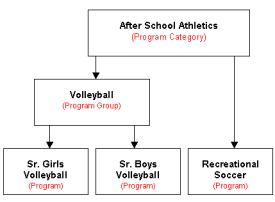
To provide flexibility in how districts organize and manage programs, programs have three levels of organization:
| = | Program Category - Program categories are the first level of organization. All program groups and programs are contained within a program category. For example, After School Athletics. |
Students are not enrolled directly in program categories; rather, they are enrolled in programs contained within program categories.
Note: Program groups are not required.
[Figure 247] illustrates the relationships between program categories, program groups, and programs:
Figure 247: Program organization

You can change the program category names and create custom program categories by editing the Program Management Setup Lists. For more information about working with Setup Lists, see Working with Program Management Setup Lists [>>].
Program Management provides several predefined program categories. These are primarily US federally-managed programs. Predefined program categories include:
Table 46: Predefined program categories
|
Program Category |
Types of Programs |
|
Support innovative learning and augment the standard curriculum or enhance student academic performance. |
|
|
Supplement educational services. These programs are available after regular school hours and do not fall into the Academic Enhancement program category. For example: community work programs; student volunteer programs; or other educational programs with a social component. |
|
|
Promote physical education and sports activities that are not part of the standard course curriculum, e.g., school sports teams, cheerleading, and so on. |
|
|
Enhance school readiness of children. Includes programs such as HeadStart or Title 1. These programs focus on basic skills such as color recognition, number recognition, and basic language skills. |
|
|
Support students with limited English skills. These programs focus on increasing the student's level of proficiency so they are not hindered in the classroom. |
|
|
Provide economically or socially challenged students with access to free or reduced meal programs. Depending on the student's situation, these programs can include other meals and snacks, as well as lunch. These programs monitor USDA meal services. Free and Reduced Meal programs usually require sessions for each school to allow students using the program to be tracked. |
|
|
Provide an accelerated and enriched curriculum. Students may need to be enrolled in this program before they can be registered for Gifted/Talented classes. |
|
|
Support students unable to attend classes at the physical school location. For example, a student who is hospitalized for an extended time might have a teacher come to their hospital to assist with their schoolwork. |
|
|
Ensure equal access to education for homeless students. Students who are homeless can be given additional learning and support opportunities to help them keep up with their studies. |
|
|
Provide opportunities for students who qualify for migrant programs to help them keep up with their studies. |
|
|
Support programs for students requiring non-district services. For example, students with severe disabilities may require access to programs or services which are not available in their home district. Note: Generally, students are only placed outside their district after the district has tried all available forms of instructional settings (from least restrictive environment to most restrictive) and the results are not effective. Students may also be placed outside the district if the student is deemed dangerous to themselves or others. |
|
|
Track IEP and 504 status students. These programs support students with physical or learning disabilities who require specialized learning environments, such as braille. |
|
|
Provide transportation to/from school for qualifying students who face transport challenges. For more information, see Setting up Transportation Programs [>>]. Note: Transportation program setup is accessed directly from the District Setup page under the District heading, not from Program Setup. |

www.powerschool.com
Tel: 866-434-6276
Email: smssupport@powerschool.com
Copyright 2015-2016 PowerSchool Group LLC and/or its affiliate(s). All rights reserved. All trademarks are either owned or licensed by PowerSchool Group LLC and/or its affiliates.